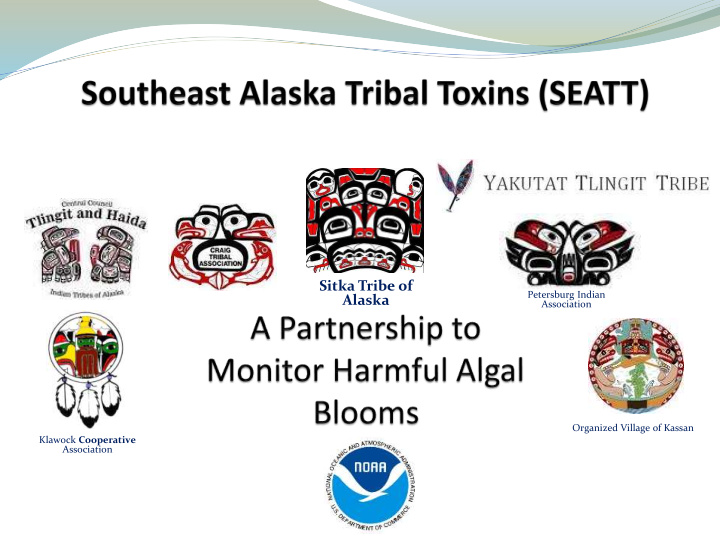



Sitka Tribe of Petersburg Indian Alaska Association Organized Village of Kassan Klawock Cooperative Association
Overview How SEATT was formed and the commitment Background on Harmful Algal Blooms (HABs) and importance of subsistence harvest Toxins, their effects, and distribution Regulatory authority SEATT monitoring and the benefits Biotoxin Lab Funding
WHY A PARTNERSHIP? A Common Concern about subsistence clam resources No assistance from AK state agencies STA reached out to SE Tribes FY 15 EPA IGAP funds for baseline phytoplankton Create an early warning system S outh E ast A laska T ribal T oxins November 2013
Traditions and Culture Subsistence user groups play toxin roulette when harvesting bivalves in Alaska. Coastal Alaskan Native populations are 12 times more likely to be affected by PSP than the Caucasian community because of the greater use of subsistence foods (Gessner and Schloss, 1996).
Background on HABs and the increase due to climate change. PSP was first acknowledged as an environmental problem in 1799 when the crew of Alexander Baranof from the Russian American Trading Company ingested blue mussels containing high levels of PSP in southeast Alaska (Fortuine 1975). Paralytic shellfish poisoning (PSP) is caused by the saxatoxins released by Alexandrium catanella Amnesic shellfish poisoning (ASP) is caused by domoic acid released by Pseudo-nitzchia With rise in sea water temps due to climate change, HAB species will be more prevalent throughout the year.
H UMAN H EALTH S YNDROMES – Associated with Phytoplankton S YNDROME S PECIES AND T OXIN S YMPTOMS Permanent short Amnesic Shellfish Pseudo-nitzschia term memory Poisoning (ASP) Domoic acid loss Temperature Ciguatera Fish Poisoning Gambierdiscus toxicus Sensation Ciguatoxin & Maitotoxin (CFP) Reversal Diarrhea Diarrhetic Shellfish Dinophysis Nausea Poisoning (DSP) Okadaic acid Vomiting Neurotoxic Shellfish Gastrointestinal and Karenia brevis Neurological Problems Poisoning (NSP) Brevetoxin Paralytic Shellfish Loss of motor Alexandrium Poisoning (PSP) control Saxitoxin
Alaskan Alexandrium spp. The dinoflagellate Alexandrium catanella (formerly Gonyaulax catanella/catenatum ) produces saxitoxin, a highly potent neurotoxin, which, if consumed, causes paralytic shellfish poisoning (PSP).
Comparative Lethality of Selected Toxins & Chemical Agents in Laboratory Mice AGENT LD 50 MOLECULAR SOURCE ( g/kg) WEIGHT Botulinum toxin 0.001 150,000 Bacterium Shiga toxin 0.002 55,000 Bacterium Tetanus toxin 0.002 150,000 Bacterium Abrin 0.04 65,000 Plant (Rosary Pea) Diphtheria toxin 0.10 62,000 Bacterium 0.10 #5 Maitotoxin 3,400 Gambierdiscus 0.15 #7 Palytoxin 2,700 Ostreopsis #8 Ciguatoxin 0.40 1,000 Gambierdiscus Textilotoxin 0.60 80,000 Elapid Snake C. perfringens toxins 0.1 - 5.0 35-40,000 Bacterium Batrachotoxin 2.0 539 Arrow-Poison Frog Ricin 3.0 64,000 Plant (Castor Bean) alpha-Conotoxin 5.0 1,500 Cone Snail Taipoxin 5.0 46,000 Elapid Snake Tetrodotoxin 8.0 319 Puffer Fish alpha-Tityustoxin 9.0 8,000 Scorpion #17 Saxitoxin 10.0 (Inhal 2.0) 299 Alexandrium & Gymnodinium VX 15.0 267 Chemical Agent SEB (Rhesus/Aerosol) 27.0 (ED 50 ~pg) 28,494 Bacterium Anatoxin-A(s) 50.0 500 Blue-Green Algae Microcystin 50.0 994 Blue-Green Algae Soman (GD) 64.0 182 Chemical Agent Sarin (GB) 100.0 140 Chemical Agent Aconitine 100.0 647 Plant (Monkshood) Brevetoxin 180.0 1,000 Karenia brevis
2011 reported blue muscles at >50,000 ug/100g in Ketchikan Maximum PSP toxins (1991-2011)
Who regulates for PSP and toxins in Alaska? Alaska Department of Environmental Conservation follows FDA regulations for all commercially harvested shellfish in Alaska under the National Shellfish Sanitation Program 80 ug of toxin/ 100g of shellfish with mouse bioassay
What about subsistence users? Alaska has NO SUBSISTENCE OR RECREATIONAL regulatory testing. ADEC will not certify any intertidal harvest for subsistence use.
What does monitoring look like? Microscopy Net tow and for ID and WQ field cell count sample /abundance Filter Shellfish sample in collection, lab and shipped to test for Sitka toxins
Monitoring Components • Collect & process seawater samples weekly • Record oceanic parameters • Identify presence of HAB species • Enumerate target species • Describe phytoplankton species diversity • Measure toxins (cellular) • Ship shellfish samples to Sitka Sentinel mussel cages (2016)
Equipment and Training Equipment • Digital Microscope with Camera • Refractometer and Thermometer • Phytoplankton Net • Filtering apparatus • Identification tools Training • Workshops in Sitka Cell • Developing Manuals/Training DVD counts & imaging (UAS) training • Site Visits Quarterly Newsletters and Updates to SEATOR.org
Where does all the data go? SoundToxin Database and Phytoplankton Monitoring Network (NOAA) National database for all monitoring groups Used by researchers, shellfish growers, and resource managers for early warning system
Other Partnerships doing HAB monitoring Olympic SoundToxins Region Partnership Harmful Algal Bloom • Tribes (ORHAB) • NOAA Partnership • Volunteers • Non-Profits • Tribes • Shellfish • NOAA • Volunteers Growers • Non-Profits • Shellfish Growers www.orhab.org www.soundtoxins.org
Benefits for REAL Time monitoring EARLY WARNING system Develop forecasting tools Provide outreach to Tribal Citizens about the potential for health risk related to subsistence harvest. Coordinate with local and state health departments Provide the SEATT partners with a unified baseline data set. Credibility Ketchikan noctiluca bloom 2009
STA Toxin Analysis Lab Lab can be used to conduct regulatory sampling for SEATT partners for PSP and other toxins using RBA techniques Ability for Tribes to establish their own subsistence shellfish management plans based on sampling data Possibility to incorporate other needs that Tribes may have: OA, traditional foods, etc . Icing on the cake
Looking to the Future Funding EPA IGAP funds ($30K/SEATT partner/year: $270K/year) STA and CCTHIA EPA unmet needs for technical training and workshops ($150/year) STA-EPA unmet needs for cellular toxin analysis ($75K OCT 2014) STA -BIA funding for technical standard operating procedure manual ( $48K NOV, 2014) STA-ANA Environmental Regulatory Enhancement for FDA certified regulatory lab($600K 2015)
TRAINING WORKSHOPS IN SITKA May 11-15 2015, November 2015 Current SEATT partners are funded for travel, lodging, per diem. Possibility for additional interested Tribes to attend. NOAA, WDOH, UAS Dr. Vera Trainer Dr. Steve Morton Kate Sullivan Jerry Borchert
Questions or Comments? Chris Whitehead Environmental Program Manager Sitka Tribe of Alaska Resource Protection Department 907-747-7395 chris.whitehead@sitkatribe-nsn.gov
Recommend
More recommend